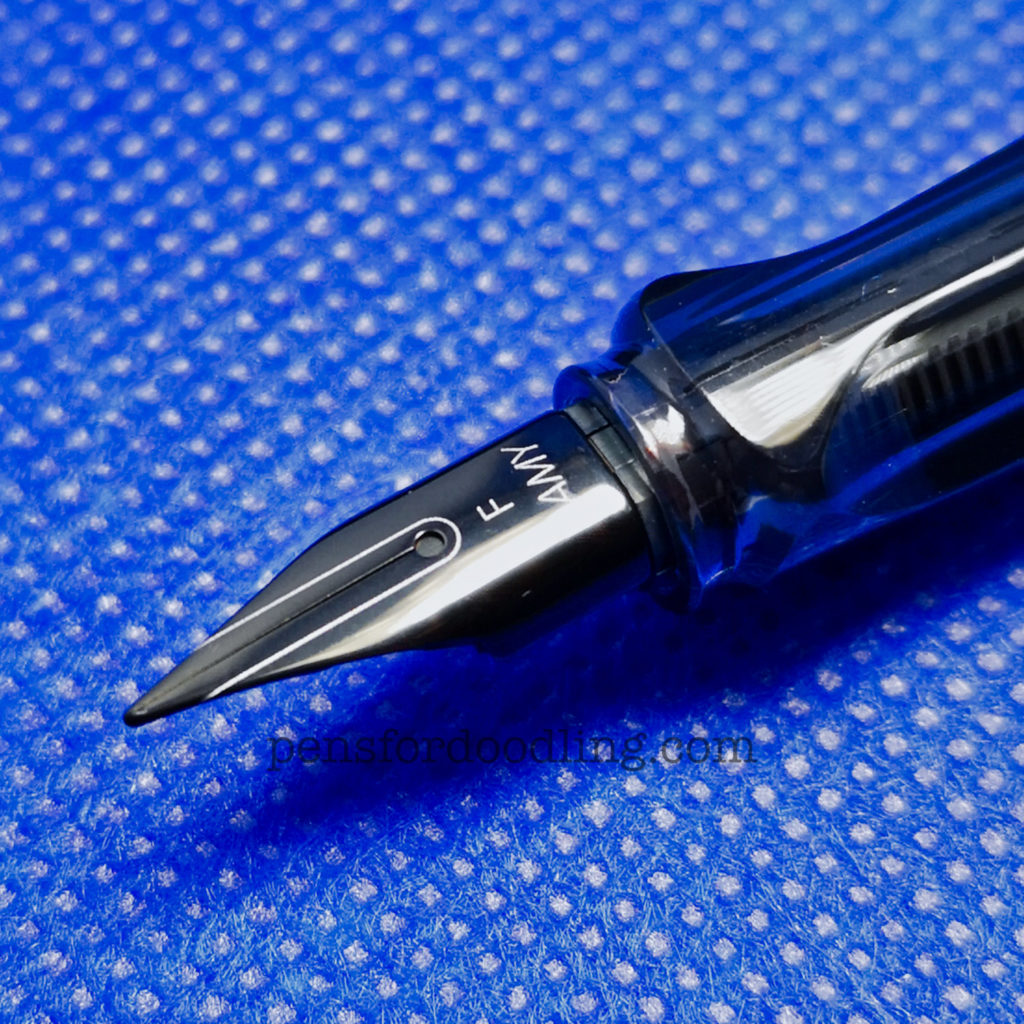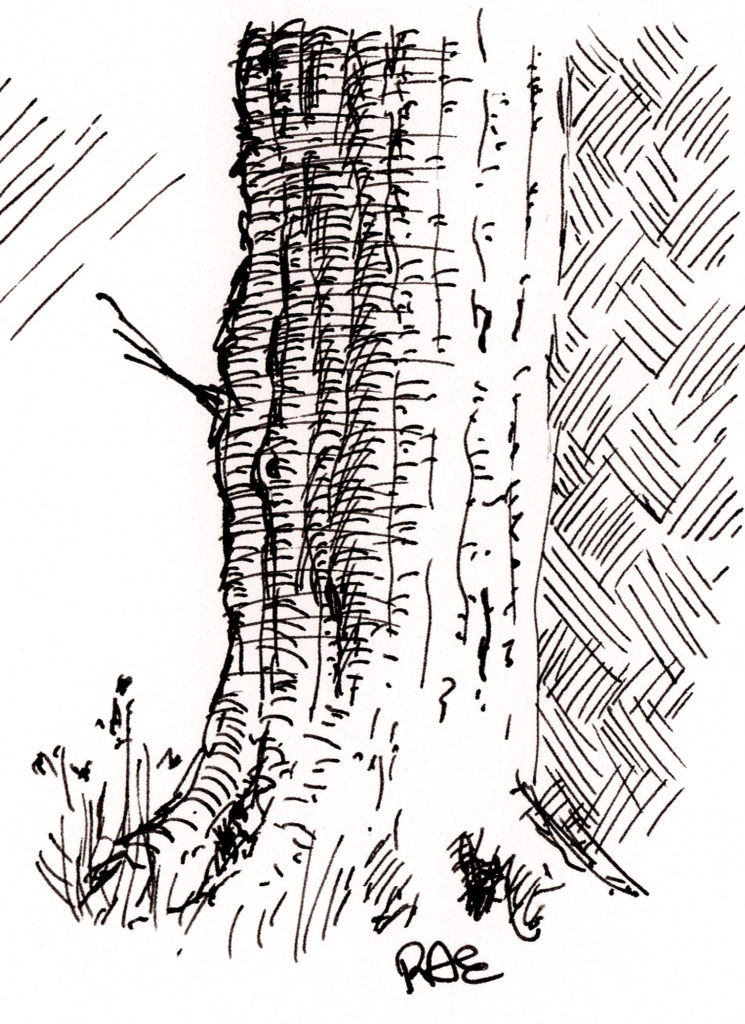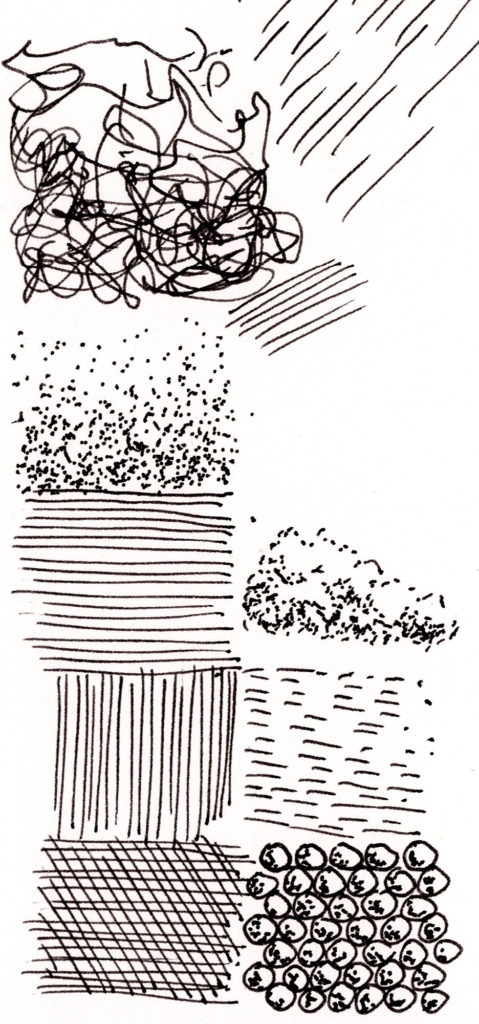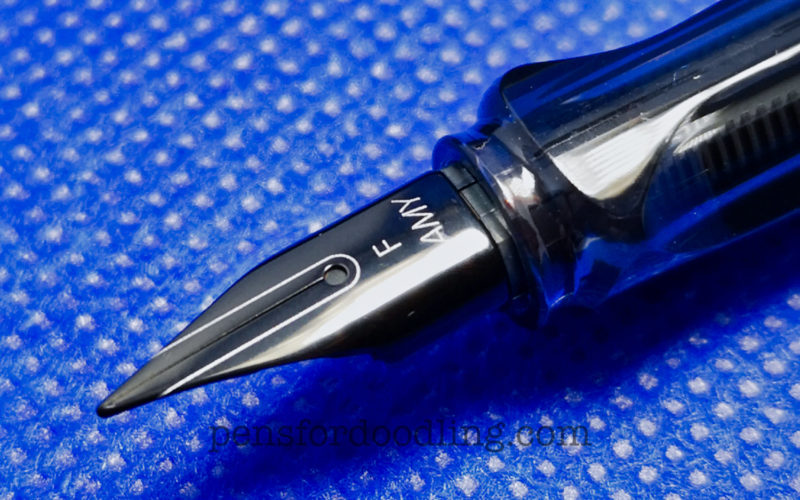In this review I’ll be testing the Lamy LX Marron fountain pen to find out if it’s an ideal tool for doodling or just a pretty pen in a shiny tube.
If you’d rather watch a video than read, I’ve created a review on YouTube. You can view it at the bottom of this page.
I like Lamy fountain pens, but I think that there’s little difference between their most affordable models (the Safari, Vista, and Al-Star).
My first Lamy was a Safari in Lime Green a few years ago. It was a birthday present from my wife and I still love it. The nib, weight, and balance are all pretty good for doodling and sketching with, plus the colour’s nice too. It’s proven to be a very reliable pen.
I later acquired a Vista and was a little disappointed to discover it was, to all intents and purposes, just a demonstrator Safari (it’s literally identical other than being clear).
Pens in the Al-Star range also look like they might be Safaris too. They’re a little bigger and made of aluminium but other than that, it’s hard to tell them apart.
I’ve never bought one because much as I like my Safari and Vista, I don’t really need another Safari look-alike, even if it is slightly larger (although I do like metal pens).
Then I came across the LX Marron Special Edition.
Special Edition labels confuse me.
I’m not sure if the LX Marron is a Special Edition LX, or a Special Edition Al-Star. Fortunately it doesn’t matter because I bought the pen because it looks awesome not because it’s ‘special’.

One of the things that attracted me to the pen was its lovely chocolate-brown finish. Apparently, “Marron” is “chestnut” in French but I’m going to stick with the chocolate description. I like chocolate.
It’s not pronounced “Ell-Ex”, It’s “Lux”
Incidentally, Lamy don’t want people calling the pen the LX (as in “ell-ex”). They want us to read it as, “Lux” because the LX represents the higher end of the Al-Star range. Okay, Lamy.
Key Features of the LX
The LX and Al-Star ranges are very similar indeed. In fact, there are only a few distinct differences between them.
The main ways in which the LX pens differ from the Al-Star pens are:
- The pocket clip on the LX is plated to match the barrel finish
- The Lamy logo on the barrel has a glossy finish instead of being an outline of the letters
- The finials (end caps), like the pocket clip, are coated to match the barrel coating and are metal (unlike the plastic caps of the Al-Star)
- The nib has a fancy black finish instead of the plain steel nib of the Al-Star/Safari/Nexx/Studio pens
The pocket clip
The clip seems pretty solid, looking like a bent piece of wire that’s nicely coated with a finish to match the anodized cap it’s mounted on.

I don’t really care too much about pocket clips as I rarely use them but for those that do, I’d imagine the clip would keep the pen in place. It has a fair amount of grip when I tried it.
The nib

Perhaps the biggest difference and one of the features that made this pen call out to me is the nib.
The nib on the LX is a glossy black, and differs from Lamy’s common steel nib in a couple of ways. The slit between the tines appears to be longer and it ends with a breather hole.
The black effect is the result of the PVD (presumably ‘Physical vapor deposition‘) coating. Apparently offering a scratch-resistant surface in addition to a smoother writing (or in my case, drawing) experience, I’m curious if this makes an appreciable difference in use.
I’ll let you know when I test it later in the review.
According to Lamy:
“The PVD coating is extremely scratch proof, does not tarnish, retains its surface properties and produces excellent depth of colour.”
https://www.lamy.com/en/the-fountain-pen-an-expression-of-personality/
Packaging
The LX doesn’t come in the basic cardboard box or plastic blister pack that you’d get with a Safari or Al-Star. No, instead it comes suspended in an aluminium tube, anodized to match the barrel of the pen.
This is probably to make the pen feel a little more luxurious (LXurios?) but it seems an extravagance to me.
Some people might like to lovingly return it to its little coffin between uses but I tend to forget about the boxes once I’ve started to use a pen.
To prevent any pre-sale scratches, the fancy tube has a cardboard wrapper around it.
At least there’s no single-use plastic, I suppose.
How it feels
There’s a pleasant silkiness to the anodised surface of the barrel that feels good in the hand but I won’t be gripping the barrel when I’m sketching or writing.
The section (grip)
The section of the LX is similar to the Safari, Al-Star, and Nexx, with the same triangular shape to encourage proper finger-positioning.
The smokey-grey transparent plastic of the section compliments the colour of the barrel nicely.
I like the grip and find it quite comfortable but there are those that disagree so it’s probably a personal preference.
The section feels a little too smooth for my taste and the transition from the grip faces to the lower curve of the section felt a little sharp when my fingers strayed that far. That shiny section could become a problem when working with the pen for long periods.
Balance
In use, the pen feels very light (as you’d expect from aluminium).
I personally think that the Safari feels better balanced in use but I may revise that opinion once I’ve had chance to use the LX more intensively.
Posting the cap immediately made the pen feel top-heavy and I could feel the tilt of the nib in my hand. The shift was so noticeable that I can’t imagine ever using the pen with the cap posted. This is disappointing but not a deal breaker. I’ll just have to be careful not to lose the cap!
Inking the pen
The most important point to note about the LX (and all pens in the Nexx, Safari, Vista, and Al-Star ranges) is that it only accepts Lamy’s own T10 cartridges.
Generic international ink cartridges are not compatible.
Mine came with a cartridge in the barrel containing Lamy’s standard blue ink. I won’t be using that for doodling as I don’t really care for the shade and it has virtually no water-resistance when dry.

An alternative is to use Lamy’s proprietary ink converter if you want to use bottled inks.
The pen initially comes with a cardboard ring between the section and the barrel. There’s a reason for this.
Once you’ve removed the ring, if you carry on tightening the thread with a T10 cartridge inside, it will push the cartridge onto the capillary and (usually) open the cartridge. Alternatively you can take your chances with pushing the cartridge onto the capillary yourself.
You can see this ring in my photos above as I used it to stop the pen rolling around when I was trying to photograph it.
A money (and planet) saving tip
When your T10 cartridges are empty, don’t throw them away.
I refill my old T10 cartridges with bottled fountain pen inks using a syringe. Since I started doing that years ago, I’ve yet to throw a cartridge away.
I’d imagine that eventually the neck of the cartridge might become loose from repeated insertions into the pen but so far they all fit well.
Drawing with the Lamy LX
Getting the ink flowing
I used my own black T10 cartridge instead of the blue one that came with the pen as I don’t really care for drawing in blue ink. As they’re both official Lamy cartridges, I doubt my results would have been any different with the blue one.
Getting the ink going in the pen was remarkably easy. I removed the cardboard spacer ring, screwed on the barrel (which pushed the T10 cartridge onto the feed) gave the nib one gentle tap and the ink was flowing without a problem.
This has to be the fastest I’ve ever had the ink get from the cartridge to the nib tip for a new pen. Ready to go in 2-3 seconds.
The ink flowed consistently from that point onwards without a single skip or stutter.
I’m very impressed.
Line quality & Flow
The nib flowed exceptionally well, and bear in mind this is a fine nib. I know that some people have experienced issues with fine Lamy nibs but the flow from the PVD-coated nib was exceptional.
Flow was on the wet side but just right for drawing fast lines.
Speaking of fast lines, I was able to draw lines rapidly with absolutely no skips or gaps in the line. I’m even more impressed, considering the nib size.

The flow was only a problem when I started doing very dense hatching and the surface fibres of the glossy card started to clog the tines.
If I was drawing carefully instead of a messy sketch this probably wouldn’t have been an issue but I’d saturated the medium with rapid strokes. With a different surface and more controlled hatching, I might not have had such a problem.
Hatching With The LX

Shading and hatching was absolutely wonderful with the Lamy LX.
Strokes were consistent in size and flow with no snagging and little friction, no matter what speed I laid the line.
Direction and pressure had little to no impact on the line quality.
Pressing on the nib offered a slight separation of the tines, widening the lines perceptibly but I wouldn’t be comfortable using such pressure often. I’d say the nib is about the same hardness as any other Lamy steel nib (which are generally recognised as ‘nails’).
Stippling appeared to be achievable too. I only tried a small 15mm square, achieving a simple gradient with no missed points.
I’d have to try a larger area to really test the pen’s capabilities in this area and may do so if I ever have the time.
Final thoughts about the Lamy LX
The LX has proven to be a delightful tool to draw with, offering rapid ink provision from a new cartridge, smooth strokes, and consistent flow, regardless of stroke speed.
My initial concerns over the balance proved unfounded as I soon forgot that I was even holding the pen as I doodled but this was without the cap posted on the end. I have no desire to try drawing with the cap posted as it just felt wrong before I’d even tried to draw a stroke.
The pen looks great, the build feels solid, and the ink flow is perhaps the best I’ve ever experienced, more so even than the Muji fountain pen.
The Muji might finally have some competition as my favourite drawing tool.
Test Images Drawn With the Lamy LX

Video Review
For your convenience (some people prefer watching videos), I’ve also reviewed the Lamy LX on YouTube too.

